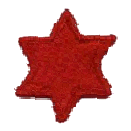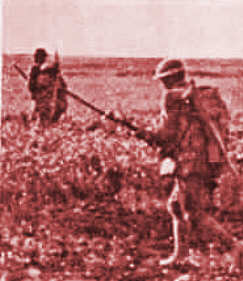
The Story of the American Expeditionary Forces
|
6th Division

|
Shortcomings
of the
AEF's Tactical Doctrine
|

US Riflemen in the Open
The Basic Element of AEF Tactical Doctrine

|
Writing in 1921 former German General Staff officer Lt. Col. Herman von Giehrl recalled the evaluation of the Americans in combat he had held in the summer of 1918:
| The military significance of the Americans lay not only in their numbers but, more than anything else, in their unused nervous force. The troops were conspicuous for their absolute freshness, their physical and hence their moral superiority, and a certain ignorance of, and, therefore, and indifference to danger. Training technique, attacking power, and real fighting value, on the other hand, were less in evidence.
|
On July 18, 1918 the Allies with American troops in the forefront shifted from the Defensive to the Strategic Offensive. Going on the attack the shortcomings of AEF recollected by Col. Giehrl
would start to magnify.

Limited Transportation and Bad Roads Hampered the AEF
The performance of the US 1st Army would receive similarly critical report cards for its performance from both the German General Staff and the AEF General Headquarters despite the quick success of the effort.
German
The initial attack was carried out according to schedule but the successive waves showed great inaptitude in following up the advance. Officers as well as men did not understand how to make use of the terrain. Instead of seeking protection when they encountered opposition they merely fell back. To crawl backward or forward on the ground or to advance in quick jumps does not seem to by understood by the Americans. They remain lying on the ground for the time being, and then just stand up again and try to advance.
Neither in mass formations nor individually do the Americans know how to conduct themselves in an attack.
The higher command, also, did not understand how to grasp quickly the new situation and exploit it to the best advantage. After the infantry had reached its objective the higher command failed. They were not familiar with the tactical principles in the use of divisions and attack units for the destruction of the enemy. It was therefor possible for the [German] Army Detachment, under the most difficult conditions, to extricate itself from its precarious situation in one night, and, with only a short distance intervening between it and the enemy, to occupy new positions of resistance…
|
U.S.
| Assault formations too dense and lacking flexibility. . .scouts seldom used. . .supporting arms improperly deployed. . .junior officers show little initiative. . .command HQ too far in the rear.
|
Exactly two weeks after St. Mihiel, the greatest battle of the AEF, the Meuse-Argonne Offensive began. With some units redeployed from St. Mihiel without any chance to digest the lessons they had just learned and with other divisions placed into the line with minimal training, things came unraveled.
According to Alan Millett and his associates who grade the AEF with a D for tactical performance::
| The US approach to war [had become] basically attritional and the US also failed to emphasize surprise and exploitation of advantages. The failure to capture Montfaucon on the first day of the Meuse-Argonne Offensive was the biggest example of this. The 4th Division could have circled the hill as the 79th division in front was stalled. But, directives hindered the thinking of commanders and the Germans reinforced the position, helping stall the offensive.
|

The 35th Division on the Attack the Second Day of the Argonne Offensive
The Germans Staff after the start of the Argonne. Offensive put it rather brutally in one of their analyses:
| The American Infantry is very unskillful in the attack. It attacks in thick columns, in numerous waves echeloned in depth, preceded by tanks. This sort of attack offers excellent objectives for the fire of our artillery, infantry and machine guns.
|
In 1989 Historian and Army Officer Rod Paschall analyzed what had happened to the AEF.
| It had gone wrong. [in the Argonne]. Even in the best of conditions it was doubtful whether nine divisions could be supported over such a poor network of roads. The Americans were tied to a simple but inflexible plan that called for attacking on line, anchoring flanks with the advance of neighboring units, and keeping within the confines of divisional boundaries, a system that the Germans had learned to abandon long before.
|
Col Paschall explains there was a problem with basic tactical doctrine. of the AEF:.
…American doctrine was based on the 1917 Field Service Regulations, which were hardly revised from the prewar 1911 version. The manual specified that the attack should be conducted under the conditions of fire superiority , with advance achieved by infantry rushes. Fire superiority was to be gained by accurate rifle fire. For the Americans, the bane of Western Front attackers--the machine gun--was viewed as a "weapon of emergency". . .To be sure, artillery would assist the infantry, but the soul of an American assault was the rifleman.
General Hunter Liggett, observed in April 1918 that he could find no definitive U.S. instructions on open warfare. There was little doubt that all the U.S. officers talked about it, but when one attempted to find precise doctrine for its execution, the existing literature was a bit thin. Liggett made his concern known to Pershing's headquarters, and action was eventually taken. New Doctrine was published--after the war was over.

US Infantry and Artillery Became Better Coordinated In the Last Stages of the Argonne Offensive
…There was no question that the individual American soldier [in the Great War] fought, and fought well. But the types of attacks they were conducting were extremely costly. Their leaders appeared to have no concern for losses. The American assault was little more than a human wave into the face of German machine guns, a weapon that the Americans treated with contempt. Their doctrine favored the rifle, yet except for a few highly skilled marksmen their use of that weapon appeared to be little different than that of their European counterparts. They insisted on huge, divisions, perhaps because the knew they did not have the officers to direct a larger number of more reasonably sized units. However, [after the slow down in the Argonne ] they were in the process of reducing the size of these organizations. Pershing was also eliminating some of his more inept general. And, most important, they were attacking. Losses or not, the Americans kept coming on.
|
The AEF had to learn as it fought. especially after it went on the offensive. Army Historian Kenneth Hamburger points out that the AEF had a system for learning lessons and disseminating them rapidly to the fighting units. [Some of those lessons are summarized in other sections of the Tactical Doctrine Series of the Doughboy Center.]
| With a rigid but workable system for rapidly digesting battlefield experiences, [the AEF] did quite well at learning the rudiments of warfare in a very short time. Whether such a system would have continued had the war lasted into 1919 or whether it would have evolved into a more flexible one for developing and disseminating doctrine is a matter for speculation. Again, the most serious challenge stemmed from the general lack of experience in military matters throughout the AEF and not just in the lower ranking soldiers who had limited responsibilities.
|
|
|
Sources and thanks:
German Gen Hq. Document of September 25, 1918
THE AMERICANS IN ATTACK: On Sept. 12 Against Army Detachment C.
German Meuse Group East Document of September 29, 1918,
LESSONS TO BE DRAWN FORM THE FIGHTING ON THE WEST BANK OF THE MEUSE, Army Corps HQ.
GHQ - AEF, G5 Document 1348, Sept. 1918.
Lt. Col. Hermann von Giehrl, "The American Expeditionary Forces in Europe, 1917-1918", Infantry Journal, Volume 19.
Kenneth E. Hamburger, Learning Lessons in the American Expeditionary Forces, United States Army Center of Military History CMH Pub 24-1.
Alan R. Millett and Associates, Military Effectiveness.
Col. Rod Paschall, The Defeat of Imperial Germany, 1917-1918.
And thanks to Ray Mentzer and Herb Stickel for providing the photos. MH
|
To find other Doughboy Features visit our
Directory Page
|
For Great War Society
Membership Information

Click on Icon |
For further information on the events of 1914-1918
visit the homepage of
The Great War Society
|
Additions and comments on these pages may be directed to:
Michael E. Hanlon
(medwardh@hotmail.com) regarding content,
or toMike Iavarone (mikei01@execpc.com)
regarding form and function.
Original artwork & copy; © 1998-2000, The
Great War Society
|






